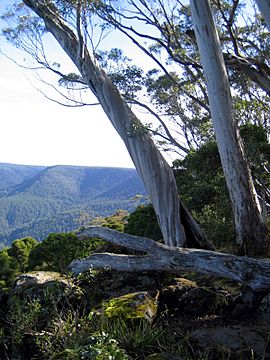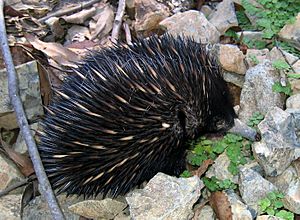Barrington Tops National Park facts for kids
Quick facts for kids Barrington Tops National ParkNew South Wales |
|
|---|---|
|
IUCN Category Ib (Wilderness Area)
|
|

The view from Captain Thunderbolt's lookout over Barrington Tops
|
|
| Nearest town or city | Gloucester |
| Established | 3 December 1969 |
| Area | 765.12 km2 (295.4 sq mi) |
| Managing authorities | NSW National Parks & Wildlife Service |
| Website | Barrington Tops National Park |
| See also | Protected areas of New South Wales |
The Barrington Tops National Park is a special protected area in New South Wales, Australia. It's located in the Hunter Valley, about 200 kilometres (124 miles) north of Sydney. This park was officially created in 1969. It covers a huge area of 76,512 hectares (that's about 190,000 acres!). You can find it between towns like Scone, Singleton, Dungog, Gloucester, and East Gresford.
Barrington Tops National Park is part of the amazing Gondwana Rainforests of Australia. This group of rainforests is so important that it's a World Heritage Site. It was added to the World Heritage list in 1986. Later, in 2007, it was also added to the Australian National Heritage List. The park is also a very important place for birds. It's known as part of the Barrington Tops and Gloucester Tops Important Bird Area.
Contents
Exploring Barrington Tops National Park
What is the Land Like?
Barrington Tops is a high plateau, like a flat-topped mountain, within the Mount Royal Range. This range is part of the much larger Great Dividing Range. Scientists believe Barrington Tops was once an active volcano, but it's now extinct. The mountains here are made from a mix of different rocks, with a top layer of granite. Over millions of years, the granite has been worn down by weather. You can see rounded granite boulders in some parts of the park. The rocks here are incredibly old, formed 300 to 400 million years ago. That was long before Australia separated from the ancient supercontinent called Gondwana.
What is the Weather Like?

The weather in the park changes a lot depending on how high up you are. In the lower areas, it's a mild climate. But at the highest points, it can get very cold, almost like an alpine region. The lowest temperature ever recorded at 1,500 metres (4,900 feet) was a chilly -17°C (1°F)!
Rainfall also varies across the park. The northwest part gets about 750 millimetres (30 inches) of rain each year. But in the southeast, it can get more than 2,000 millimetres (79 inches) of rain annually.
What Plants Grow Here?
The types of plants you find in Barrington Tops National Park change with the elevation. In the deep valleys, you'll discover warm subtropical rainforests. As you go higher, you'll see plants that like cooler, temperate climates. At the very top of the mountains, it's a subalpine environment. Snow often falls on the mountain peaks every year. Sometimes, there's so much snow that roads have to close!
Because the land is so steep and wild, many plants and animals live undisturbed by humans. You can find many types of eucalypt trees, including Snow Gums. There are also ancient rainforest trees like the Antarctic beech, which are very special. You'll also see many tree ferns, mosses, and other ferns. The park even has edible plants like native raspberries, native cherries, and lilli pillies.
What Animals Live Here?

Much of the park is remote and hard to reach. This means many shy animals can live without being bothered. Scientists have found a large number of different animals in the park. Some were even thought to be extinct before they were found here!
Some common animals you might spot include:
- Birds like barking owls, sooty owls, cockatoos, rosellas, and kookaburras.
- Mammals like eastern grey kangaroos, pademelons, bats, and echidnas.
- Many types of frogs.
The park is also very important for a bird called the rufous scrub-bird. Other special birds found here are flame robins, pale-yellow robins, paradise riflebirds, green catbirds, regent bowerbirds, and Australian logrunners.
Some animals, like quolls, native rodents, and platypus, are very shy. You might be lucky to see them! Unfortunately, some animals that don't belong in the park, like feral horses and feral cats, are being removed to protect the native wildlife.
History of the Park
Who Lived Here First?
The traditional owners of the land around Barrington Tops are Aboriginal Australian peoples. This includes the Gringai people who lived in the southern valleys, the Wonnarua people in the western country, and the Worimi and Birpai people on the eastern side.
How Did it Become a Park?
In 1969, the area between Mount Barrington, Mount Royal, and Gloucester Tops was officially named Barrington Tops National Park. In 1986, it became a World Heritage Area. Later, it was also declared a Wilderness Area. This means it's a very wild and untouched place. Some of the rivers flowing through the Barrington range are called "wild rivers." This means they are incredibly clean and pure. The highest point in the park is Brumlow Top, which is 1,586 metres (5,203 feet) high.
Aircraft Incidents
The Barrington Tops area has seen a number of aircraft crashes over the years. One spot is even named Aeroplane Hill because of a crash there. The high altitude, frequent fog, clouds, storms, and cold weather (which can cause ice to form on planes) make this area tricky for aircraft. Some people even call it the "Devil's Triangle" because of these challenges.
Several planes have crashed here, including military aircraft and passenger planes. For example, in 1948, a Douglas DC-3 plane crashed, and in 1981, a Cessna 210 went missing with five people on board. Despite many searches, no wreckage or bodies from that crash have ever been found.
The Barrington Guest House

The Barrington Guest House was a popular place for visitors to stay near Barrington Tops. It was built starting in 1925 by Norman T. McLeod. The guest house was officially opened in 1930. It was a favourite spot for people visiting the park for many years. Sadly, the guest house burned down in a fire on September 24, 2006, due to an electrical problem. There are plans to rebuild it in the future.
Visiting Barrington Tops
Barrington Tops is a popular place for people from Sydney and Newcastle to visit on weekends. There are many walking trails and camping grounds throughout the park where you can explore and stay. The park has well-maintained gravel roads, so you can usually drive around in a regular car. There are also special tracks for 4WD vehicles if you want to explore more remote areas.
Besides camping, you can find places to stay in the nearby towns of Gloucester and Dungog. The park is looked after by the NSW National Parks and Wildlife Service. Rangers patrol the park every day to keep it safe and protected.
|
See also
 In Spanish: Parque nacional Cumbres Barrington para niños
In Spanish: Parque nacional Cumbres Barrington para niños


